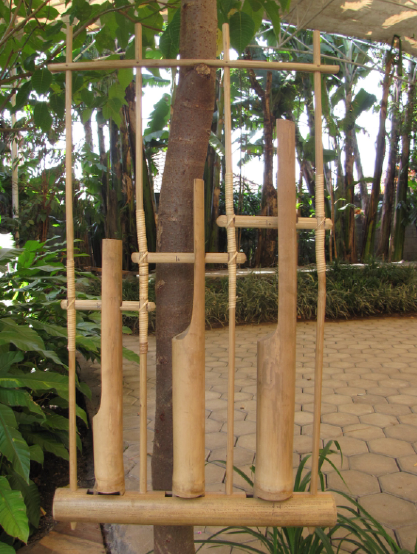Indonesian Angklung!
Thanks to a Fulbright/COTIM (Consortium for the Teaching of Indonesian and Malay) grant, I spent 8 weeks of my summer in Java, Indonesia following an advanced Indonesian language course. I really thought that this program was fantastic because they gave us many opportunities to go out amongst the people to develop our skills rather than just sitting in a classroom. For example, one week of the program was allotted for participants to travel to any part of the country and conduct a research project. After our week of research we were then required to write a 10-page conference paper in Indonesian and then deliver it at the end of the program!
For my week of research I chose to travel to Bandung, West Java to study a bamboo idiophone called angklung (see photo).

During my stay in Bandung, I met with Pak Sam Udjo from the Saung Angklung Udjo foundation for angklung and was given permission to stay at their performance and learning center. I was extremely fortunate to have been given this opportunity because Saung Angklung Udjo is the premier center for angklung activity in Indonesia. In addition to being the top producer of angklung instruments in Indonesia, they hold daily angklung classes and give performances that attract hundreds of people each day. Check out their website here! http://www.angklung-udjo.co.id/
So what is angklung? Well, angklung originated in West Java and was developed amongst the Sundanese speaking people. It is not known when angklung was first created, but it was first used in agrarian cultures during rituals to honor the rice goddess Dewi Padi or Dewi Sri. Today, angklung is still used in many contexts including, harvest ceremonies, circumcisions, parades, cultural diplomacy efforts, entertainment, and as a national music education tool.
Each angklung produces one note and is sounded by shaking the suspended bamboo tubes vigorously. A set of Angklung can be suspended and played by one person or the angklung can be distributed to a group in which each person is responsible for one note of the song. In this way, everyone has to work together to create the melody. What is so amazing about the Saung Angklung Udjo performances is that all of the audience members get a chance to play angklung, with sometimes hundreds of people playing angklung together.
For my research project I was looking at angklung and how it is used in multiple applied ethnomusicology efforts. Pak Sam Udjo from Saung Angklung Udjo was an amazing resource and enlightened me on the use of angklung in music education, music therapy, and cultural diplomacy. I wont give you my whole research paper, but perhaps just a few highlights?
As it turns out, Angklung is an amazing tool for world music education. The instruments can be tuned in both the Indonesian pelog, sulendro, or madenda scales and also the Western diatonic scale. This has done wonders for Indonesian music education, as it has not only allowed folk songs from throughout the archipelago to be taught, but also music from all over the world. During one of the concerts at Saung Angklung Udjo I was astounded to watch a full performance of Queen’s “Bohemian Rhapsody” by an angklung orchestra. Saung Angklung Udjo has also developed a number of music education methods that make angklung extremely accessible to everyone regardless of music experience. For example, they often employ cipher notation and the use of Kodaly hand signals in a way that hundreds of people can play together by simply watching a leader. The unique hocket-like playing technique is also great for building rhythmic skill and tonal awareness, and the diatonic scale makes it possible to teach many aspects of Western music theory. In my opinion, angklung could solve many of the issues faced when trying to incorporate Indonesian music in grammar school, world music education. Compared to large and expensive gamelans that are hard to transport, angklung is a much cheaper, easier, and lighter alternative.
Being that angklung is so simple, Pak Sam Udjo has also been using it as a music therapy tool amongst disabled children and retirees. Angklung has been especially effective for creating a sense of community amongst elderly citizens who suffer from loneliness, as angklung requires a group effort to be played!
Saung Angklung Udjo has also been involved in a number of cultural diplomacy efforts. In July 2011, the Saung Angklung Udjo family set the world record for the most number of people playing angklung together in Washington D.C. Over 5,100 people played together on the Washington Mall! Check out the Youtube video here. http://www.youtube.com/watch?v=P1ENtenJZpA In this way, over 5,000 Americans became more familiar with Indonesia and one of Indonesia’s musical traditions. Pak Sam Udjo and his brother were also clever in that they wrote the names of 10 of Indonesia’s major islands on the instruments. The participants were then asked to follow hand signals that corresponded to the name of the island that they had on their instrument! What a fun way to learn geography!
I also played angklung for 8 weeks in my language program in Salatiga.
You might have noticed the costume I am wearing. I am getting reading to perform a Dayak (Kalimantan, Indonesia) dance. See below for a dance too!





